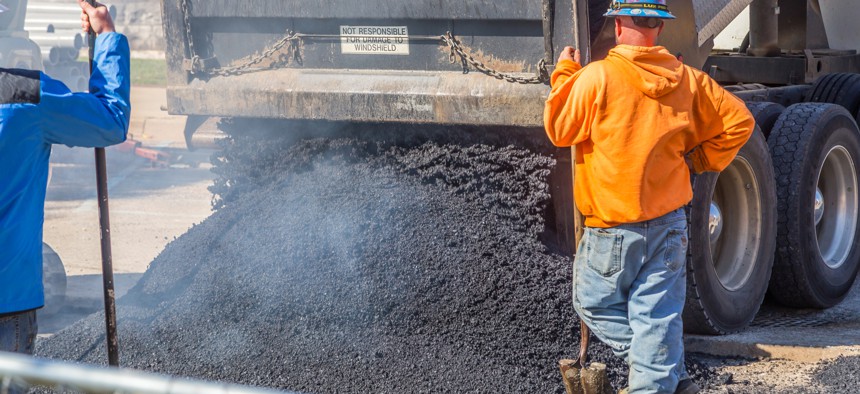Our National Infrastructure Problem Is Also a Mindset Problem

In Montgomery, Alabama (pictured) and across the nation, the never ending battle to repair potholes continues. Mccallk69 / Shutterstock.com

Connecting state and local government leaders
COMMENTARY | Pressing infrastructure concerns require a mental shift — a return to nature.
Across the nation, our roads and bridges are fighting a losing battle against natural forces. This battle leaves its scars, like the potholes that cost drivers $3 billion each year in vehicle damage and are responsible for approximately one-third of traffic fatalities. If we want to find sustainable, affordable, long-term solutions to our infrastructure problems, we need to shift our mindset away from fighting nature and find ways to imitate it instead.
State and local governments know all too well how dangerous and destructive potholes are. City repair crews are playing an unwinnable game of whack-a-mole, especially with all the rain and flooding the country has seen in recent years. They fix one hole, and two more open.
Yet these crews show up every day, undertaking the Sisyphean task of simply maintaining paved surfaces. What choice do they have? Until we implement more sustainable road surface solutions, potholes will continue to erupt faster than they can be filled.
Potholes are a serious problem on their own, but they are only one symptom of wider infrastructure struggles. The American Society of Civil Engineers reports that one-fifth of our highway pavement is in poor condition. It is a monumental challenge at all levels of government because though our roads are crumbling, infrastructure projects remain chronically underfunded.
For this reason, infrastructure fixes are a patchwork of Band-Aids that cannot begin to address underlying problems.
The root cause of many road hazards is our dangerously outdated stormwater management infrastructure. The paving materials that blanket the country — asphalt, concrete, composite — are not able to handle stormwater. The problem is exacerbated in built-up urban areas. With powerful, havoc-wreaking storms and extreme temperatures becoming the norm, it’s an ever more pressing crisis.
With all of these issues, why do we keep using old solutions to solve ongoing problems? We’ve been doing the same thing over and over and expecting different results — the very definition of insanity.
Instead of throwing good money after bad, we should be devoting resources to innovative solutions for sustainable development and infrastructure repair. Addressing infrastructure problems like potholes and stormwater runoff at the source will seem costlier at the outset. But compared with the billions of dollars spent repairing avoidable damage after major storms and flooding, it’s the most viable long-term solution.
Before we can solve pressing infrastructure concerns, we must undergo a mental shift — a return to nature.
Rather than trying to harness natural processes and bend them to our will, we need to design our green spaces, office parks, and residential communities in alignment with nature. This is biomimicry, or modeling design solutions after patterns in the natural world, and it offers the most innovative and copacetic solutions for infrastructure changes.
Biomimicry takes advantage of the world’s best design process: natural selection. When we’re talking about infrastructure design, this can mean examining how an ecosystem works symbiotically to manage water.
We are already seeing innovative biomimicry projects at work. MIT researchers engineered a modular green space modeled after natural occurrences in wetlands. It includes basins, islands, and other hallmarks of wetland ecosystems, which purify water automatically through their biological and chemical makeup. The design guidelines they released are already being used to restore Milwaukee wetlands and improve water quality in cities like Houston and London.
There are many other infrastructure solutions to be found in nature. In addition to wetlands, there is much to be learned from natural breakwater ecosystems, such as oyster beds and tide pools. Instead of fighting against nature, we can take our cues from the world around us in order to better secure our environments. In the case of road planning, this means laying down ground covers that imitate the way natural surfaces handle both water and regular wear and tear.
Nobody wants to see communities repeatedly inundated with billions of dollars in vehicle repair and flood recovery expenses. Across the U.S., infrastructure problems are increasingly urgent. Potholed roads, aging water systems, old bridges — these urgently need to be addressed in sustainable ways.
Potholes and other road hazards are like pavement acne, albeit far more dangerous. If we continue unhealthy construction habits, our roadscape will remain pockmarked and scarred. But if we use green, eco-friendly technology and work with nature instead of against it, these blemishes could clear up quickly.
Barry Stiles is the founder and CEO of TRUEGRID Pavers.

NEXT STORY: Sprocket kicks video processing into high gear




